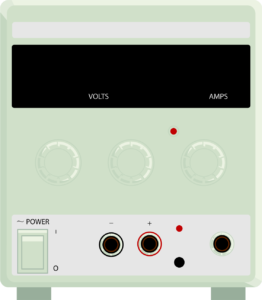This tutorial describes in short how to use the TTI lab power supply. But the information is also applicable for other DC power supplies.
Features of the power supply.
- The lab power supply gives an adjustable stabilized DC (direct current; Dutch: ‘gelijkspanning’) output voltage between the specified range (e.g. 0 and 30 V DC).
- The lab power supply includes an adjustable current limiter, which limits the output current to the set maximum (by decreasing the output voltage if the output current exceeds the set value). Using the correct current limit setting may prevent destroying your electronic circuit.
Physical layout of the power supply.

Practical usage.
Before connecting your circuit first set the power supply to the desired settings.
- Switch on the power supply using the main power switch.
- Switch the output on/off switch to off (indicator light off). The display now shows the set values for output voltage (in V) and current limit (in A). Set the desired output voltage by turning the coarse and fine voltage adjustment. Set the current limiter value a bit higher than the expected current for the circuit you are connecting using the adjustment. Be aware the display value is in A, not mA.
- Connect your circuit: turn terminals anti clockwise, put wires through the hole in the metal part of the connector that is exposed now and fix them by turning the terminals clockwise. Another option is to use banana plugs.
Connect the minus or ground of your circuit to the – (black) terminal, not to the ‘earth’ terminal at the right-hand side. Connect the voltage supply connection of your circuit to the + (red) terminal. Common practice is to us a black wire for the – connection and a red wire for the + connection. - Use the output switch to switch the output to on. The output indicator light is now on and the display now shows the actual output voltage (in V) and current (in A) (so not the set values).
- If the current limiter indicator light goes on and the voltage is below the set value, you exceed the current limit, most likely because of a mistake in making in your circuit or incorrect estimate of the current your circuit needs. You might decide to go to step 2 to change settings.
- If you change your circuit always switch off the output by using the output on/off switch.